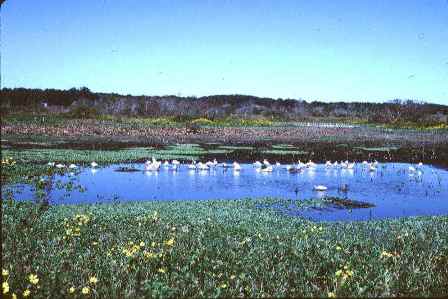Discover Florida Nature
It's time to explore the natural Florida


|
|
|
|
|
 Paynes
Prairie is biologically, geologically, and historically unique. Payne's
Prairie is located south of Gainesville, Florida, in Micanopy. This park
became Florida´s first state preserve in 1971 and is now designated as a
National Natural Landmark. Paynes
Prairie is biologically, geologically, and historically unique. Payne's
Prairie is located south of Gainesville, Florida, in Micanopy. This park
became Florida´s first state preserve in 1971 and is now designated as a
National Natural Landmark. If the Seminole Indian King Payne, who was killed in a battle with American settlers near the Georgia border in 1812, could have imagined that he would have a prairie named in his honor he would have been doubly surprised! For one thing the basin area of Paynes Prairie was a vast lake back when King Payne was alive. It was also a lake when Hernando de Soto saw it around 1540, and there was water there when naturalist William Bartram visited the site in 1774. Noted artist and naturalist, William Bartram wrote a detailed description of this area. He called it the "great Alachua Savannah." Most of the animal life he described still abounds here today, including sandhill cranes, eagles, hawks waterfowl, wading birds, alligators and otters. The water in this huge saucer-like basin has had a way of coming and going because of a sinkhole in one corner. From time to time the sink would fill with debris and the water would rise and remain. Years later the sinkhole would become unplugged, the water would drain away and the area would revert to savanna. In 1892 a small steamer plying the lake was stranded when the water suddenly disappeared. Since then the basin has remained a treeless prairie. In 1970 some 18,00 acres in the area were purchased by the state, and preservation of the prairie and it's historical function as a wildlife habitat was preserved. Over 20 distinct biological communities provide a rich array of habitats for wildlife, including alligators, bison, wild horses, and over 270 species of birds. Exhibits and an audio-visual program at the visitor center explain the area´s natural and cultural history.  A
50-foot-high observation tower near the visitor center provides a
panoramic view of the preserve. Eight trails provide opportunities for
hiking, horseback riding, and bicycling. Ranger-led activities are
offered on weekends, November through April. Fishing on Lake Wauberg is
allowed and a boat ramp provides access for canoes and boats with
electric motors. Gasoline powered boats are not allowed. The birding
superb! A list of 215 species seen here is available at the visitor
center. Also listed are twenty-seven mammals, forty-one reptiles, and
twenty amphibians native to the area. An audio-visual program explains
the purpose and scope of the activity here, and Indian artifacts are on
display. Recreational activities include bicycling, camping, picnicking,
fishing, hiking trails and horseback trails. A
50-foot-high observation tower near the visitor center provides a
panoramic view of the preserve. Eight trails provide opportunities for
hiking, horseback riding, and bicycling. Ranger-led activities are
offered on weekends, November through April. Fishing on Lake Wauberg is
allowed and a boat ramp provides access for canoes and boats with
electric motors. Gasoline powered boats are not allowed. The birding
superb! A list of 215 species seen here is available at the visitor
center. Also listed are twenty-seven mammals, forty-one reptiles, and
twenty amphibians native to the area. An audio-visual program explains
the purpose and scope of the activity here, and Indian artifacts are on
display. Recreational activities include bicycling, camping, picnicking,
fishing, hiking trails and horseback trails. The La Chua Trail, part of the 21,000-acre Paynes Prairie State Preserve, is at the southeast edge of Gainesville. The trail traverses an immense patchwork of fields and marshes. The grass and brush along the first stretch can be very good for sparrows in winter. A short side trail here leads to a pond, Alachua Sink, where you can see waders and, during periods of low water, shorebirds. The trail proceeds into wetter habitats, with a drainage canal on one side and marshes on the other, until it reaches the shallow weedy open water of Alachua Lake, the center of the Paynes Prairie basin. The Bolen Bluff Trail is on the south side of Paynes Prairie State Preserve. The trail is divided into two parts. There's an upland loop, about half of which is dry woodland dominated by laurel, live, and water oaks while the other half is shady mesic hammock forested with swamp chestnut oaks and magnolias; there are a few small ponds along the latter stretch. At the far end of the loop, a spur trail, the Bolen Bluff Dike, descends onto the Prairie basin, running through open brushy and marshy habitats for three-quarters of a mile (one-way) to an observation platform. |
|
|
Paynes Prairie State Reserve Florida
Payne's Prairie is located south of Gainesville, Florida, in Micanopy. This park became Florida´s first state preserve in 1971 and is now designated as a National Natural Landmark. The water in this huge saucer-like basin has had a way of coming and going because of a sinkhole in one corner. From time to time the sink would fill with debris and the water would rise and remain. Years later the sinkhole would become unplugged, the water would drain away and the area would revert to savanna.
Paynes Prairie is home to over 215 species of birds, along with twenty-seven mammals, forty-one reptiles, and twenty amphibians native to the area. If you are looking for a quiet spot to observe Floridian nature at its best then look no further than Payne's Prairie. Recreational activities include bicycling, camping, picnicking, fishing, hiking trails and horseback trails.
Written by: Floridian Nature
Paynes Prairie State Reserve
Date published: 10/23/2013
3 / 5 stars
|
|